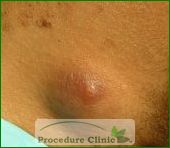Sebaceous cyst (Epidermoid cyst)
Sebaceous cysts are common benign cysts of the skin.They are small bumps that develop just beneath the skin on your face, neck, trunk and sometimes your genital area. They are slow-growing and often painless. Sebaceous cysts are almost always noncancerous, but in rare cases, they can give rise to skin cancers.
Sebaceous cysts:
- Are round cysts or small bumps that are that are attach to the skin.
- Are usually white or yellow, though people with darker skin may have pigmented cysts
- Range in size from less than 1/4 inch to nearly 2 inches in diameter
- May have a central opening that’s plugged by a tiny blackhead.
- Occur on nearly any part of your body, including your fingernails, but are found most often on your face, trunk and neck.
- Infection can occasionally occur, include thick, yellow material draining from the cyst that may have a foul odor and redness, swelling and tenderness around the cyst.
Causes
Sebaceous cysts form out of your sebaceous gland under skin. The sebaceous gland produces the oil called sebum that coats and lubricates your hair and skin. Cysts can develop if the gland or its duct, the passage where oil is able to leave, becomes damaged or blocked. This usually occurs due to a small trauma to skin.The small trauma may be a scratch or a skin condition, such as acne. Sebaceous cysts grow slowly, so the trauma may have occurred months before you notice the cyst.
Other causes of a sebaceous cyst may include:
a misshapen or deformed duct
damage to the cells during a surgery
genetic conditions, such as Gardner’s syndrome or basal cell nevus syndrome
Complications
The common complications include inflammation, rupture, and infection. In rare cases, sebaceous cysts can give rise to basal and squamous cell skin cancers. Because this occurs so seldom, Sebaceous cysts usually aren’t biopsied.
Treatments and drugs
Small cysts that don’t cause cosmetic or functional problems are usually left alone. When a cyst is inflamed, gets bigger, ruptured or infected, these treatment options exist:
Incision and drainage: your doctor makes a small cut in the cyst and expresses the contents. Although incision and drainage is relatively quick and easy, cysts often recur after this treatment.
Total excision: The surgical excision removes the entire cyst and so prevents recurrence. Total excision requires sutures.
Minimal excision: Your doctor makes a tiny incision in the cyst, expresses the contents, and then removes the cyst wall through the incision. The small wound is usually left to heal naturally.





